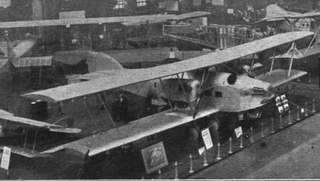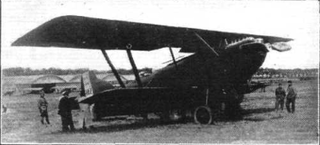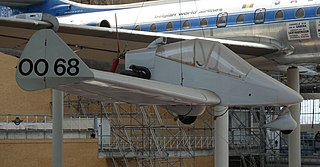Related Research Articles
The Starck AS-37 is a two-seat biplane with unconventional wing and propulsion layouts. It was designed in France in the 1970s; though three were built and more than twenty sets of plans sold for home building, no AS-37s are active in 2012.

The Starck AS-80 Holiday is a conventional two-seat, single-engine high-wing monoplane designed and built in France around 1950. It was sold in kit form but only a few were completed.

The Potez VIII was a French training aircraft which first flew in 1920. Originally it had a very unusual vertical inline engine and a four-wheeled undercarriage, though the production version was more conventional.

The Potez XVIII was a French airliner from the early 1920s, a three-engine biplane carrying up to twelve passengers.
The Potez 26 was a single seat fighter aircraft designed and flown in France in the mid-1920s. It did not reach production.

The Potez 28 was a French aircraft designed in the 1920s to set distance records, built in both sesquiplane and monoplane versions. Only two were completed but both set several long distance records.
The Landray GL.01 is a small tandem-wing, side-by-side seat sport aircraft of the Mignet Pou-du-Ciel type. Built in the mid 1970s, the single example remains active.
The Langlois JL.2 was a three-winged agricultural aircraft built in France in 1979. It failed to sell and only one was built.
The Landray GL.03 Pouss Pou was a small, pusher configuration tandem wing aircraft built in France in the early 1980s. Only one was completed, though it was much modified.
The Lebouder Autoplane was a French amateur built modular roadable aircraft, with a car-like component that could be separated from its aeronautical parts. The sole Autoplane flew and drove successfully in the early 1970s.
The Payen Pa.47 Plein Air was a French two seat, high wing single engine tourer, which first flew in 1949. Only one was built.
The Piel CP-40 Donald is a French homebuilt, single engine, single seat, high wing aircraft. It was first flown in the early 1950s, though the last of the three examples completed did not fly until almost forty years later.

The French tailless Pottier P.40 was the first aircraft designed by Jean Pottier. It flew in 1975.
The Potez 27 was a French reconnaissance biplane first flown in 1924. 175 were operated by the Polish Air Force, most built in Poland by PWS under licence. Others went to Romania, where they were also used as light bombers.
The Caudron C.220 was a two-seat French biplane trainer. Only two were built, using different engines.

The Caudron C.43 was the first French five-engined aircraft, a biplane intended for passenger transport or military use and multi-engined for safety. A development of the three-engined Caudron C.39, it had one tractor configuration engine in the nose and two push-pull pairs between the wings. It was capable of carrying eight passengers but was not developed.
The Caudron C.37 was a French three-engined biplane passenger transport, built in 1920. It could carry six passengers.
The Caudron Type B was a 1911 development of the earliest Caudron type, the Caudron Type A, with a nacelle style fuselage and more powerful engine. Initially an equal span biplane, it was modified into a sesquiplane.
The Lacroix-Trussant L.T.-51 Microplan was a French, low-powered, two seat amateur-built biplane. It flew just before the outbreak of World War II. After the war it was re-engined and flew until 1953.
The Potez 24 A.2 was a mid-1920s French biplane intended to replace the Potez 15 as an army observation aircraft. The further improved and larger Potez 25 was preferred for production.
References
- ↑ Perrier, Patrick. Fox Pappa - les avions de construction amateur (2010 ed.). Rennes: Marines Éditions. p. 74. ISBN 978 235743 048 8.
- 1 2 3 Simpson, Rod (2001). Airlife's World Aircraft. Shrewsbury: Airlife Publishing Ltd. ISBN 1 84037 115 3.
- 1 2 "Pottier p.60 Minacro" . Retrieved 2 February 2015.
- 1 2 Gaillard, Pierre (1991). Les Avions Francais de 1965 à 1990. Paris: Éditions EPA. p. 2567. ISBN 2 85120 392 4.
- ↑ Partington, Dave (201). European registers handbook 2014. Air Britain (Historians) Ltd. ISBN 978-0-85130-465-6.
- ↑ Chillon, Jacques. Fox Papa - Registre des avions Français amateur (2009 ed.). Brive: Ver Luisant. ISBN 978-2-3555-1-066-3.